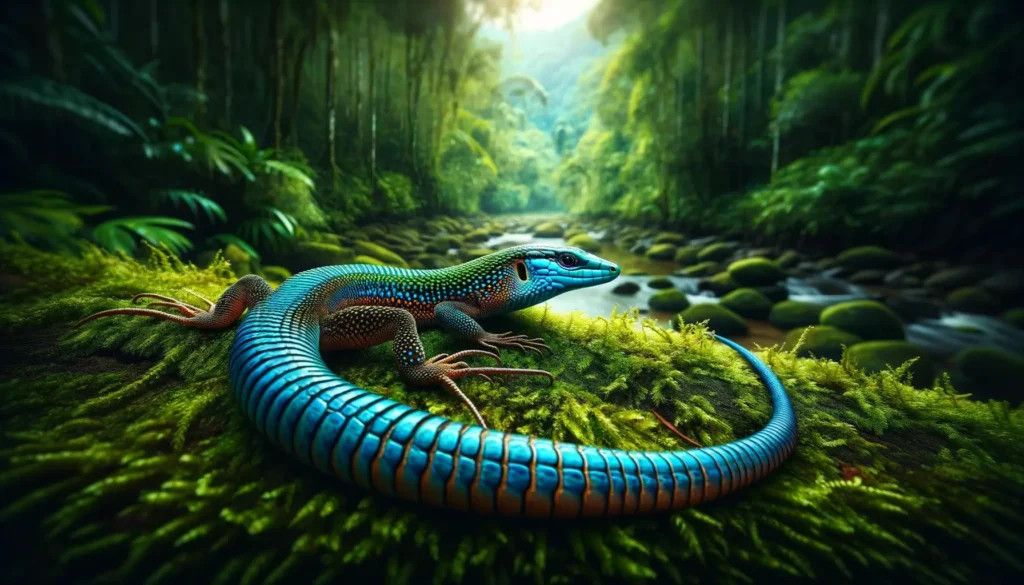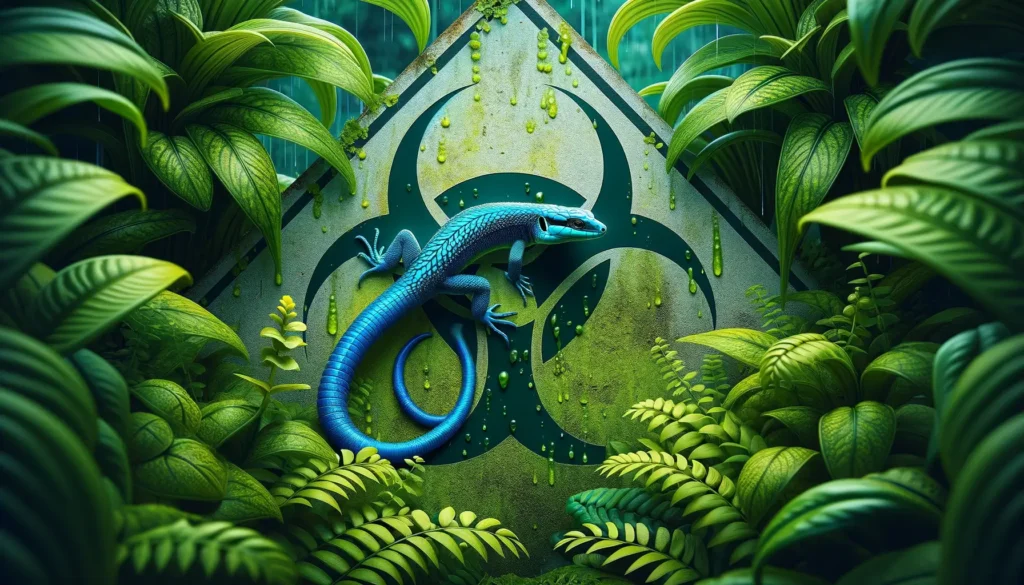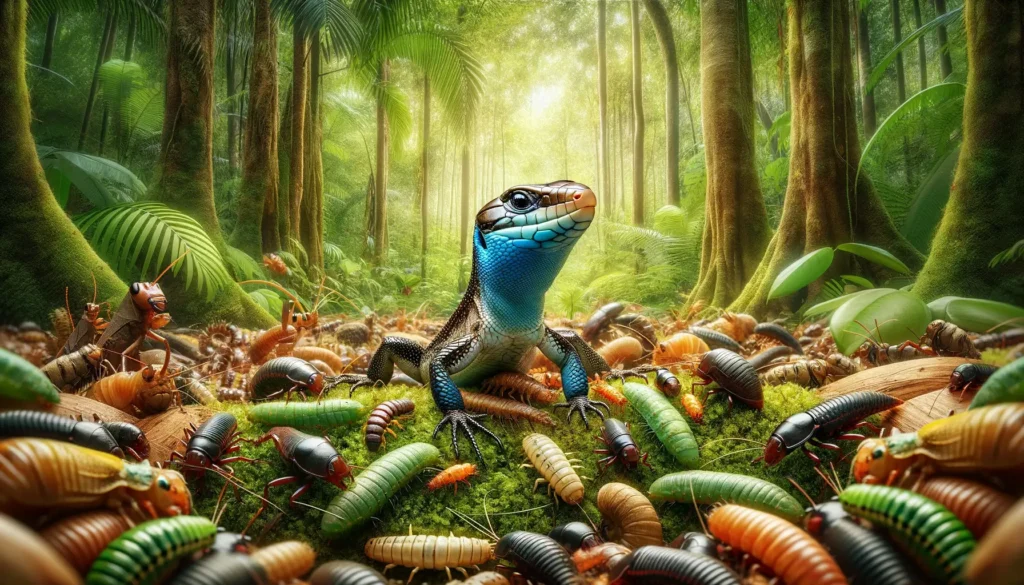Imagine you’re hiking in the Australian outback, and you come across a small, swift creature with a dazzling blue tail darting across the sun-baked soil. You’ve just encountered the blue-tailed skink, whose vibrant world is as fascinating as its striking appearance. These reptiles, while small in size, play a big role in their ecosystem and have unique behaviors and survival strategies you might find surprising. Ready to uncover more about this distinctive critter? Stick around. You’re in for an intriguing exploration.
Blue Tailed Skink
Have you ever wondered about the unique features of the blue-tailed skink, an intriguing reptile as vibrant as it is versatile? This creature is a marvel to behold, with its dazzling blue tail that serves as a defense mechanism against predators.
In the wild, the blue-tailed skink’s habitat spans a wide range, from woodlands to grasslands. They’re incredibly adaptable, thriving in different environments with great resilience. You’ll find them basking in the sun, their glossy scales reflecting the light, a sight that encapsulates the spirit of freedom.

When it comes to the blue-tailed skink diet, they’re not fussy eaters. They’ll feast on various insects, their agile bodies allowing them to dart and catch their prey precisely. This versatility in diet demonstrates their adaptability, embodying the essence of versatility and freedom.
The blue-tailed skink size is another captivating aspect. They’re not large, usually measuring up to 20 cm in length. This small size makes them ideal as pets, offering a low-maintenance yet captivating addition to your home.
Blue Tailed Skink Poisonous
While the blue-tailed skink’s size and diet might paint a friendly picture, it’s important to note that they are indeed poisonous creatures, a fact that might influence your decision to keep them as pets. The blue-tailed skink’s poisonous components are found primarily in their tails. The toxic substance is not typically harmful to humans but can be dangerous if ingested or entered the bloodstream.
This brings us to the issue of the blue-tailed skink bite. While the bite is not typically toxic, you should still be cautious. The skink’s poison could enter your bloodstream if the bite breaks the skin. The risk is minimal, but it’s a concern you should be aware of if you’re considering a blue-tailed skink as a pet.

Moreover, the blue-tailed skink’s poisonous nature extends to dogs as well. If your pet dog ingests a blue-tailed skink, they could potentially experience symptoms like vomiting, seizures, or even death in extreme cases. So, while these vibrant creatures may be fascinating to observe, it’s crucial to approach them with respect and caution.
Blue Tailed Skink Habitat
In the wild, you’d typically find blue-tailed skinks making their home in diverse environments, from forests and grasslands to rocky outcrops and semi-arid landscapes. These creatures are as adaptive as they are vibrant, making their habitat as diverse as their color palette.

How does this skink’s habitation vary across different regions? Let’s delve into it:
Blue-tailed skink Florida: They are frequently found in woodlands, taking refuge under fallen logs or basking in the sun.
Blue-tailed skink California: Rocky outcrops and chaparral ecosystems are their preferred environment, providing plenty of hideouts.
Blue-tailed skink Maryland: They inhabit deciduous forests, often camouflaging in the leaf litter.
General blue-tailed skink habitat: Across regions, they favor environments with ample hiding spots and exposure to sunlight.
These lizards demonstrate an inspiring adaptability, reminding us of the importance of flexibility and resilience. Their habitat selection reflects their survival needs and a desire for freedom and exploration. So, keep an eye out for these fascinating creatures in Florida, California, or Maryland.
Blue Tailed Skink Size
Diving into the dimensions of these vibrant creatures, you’ll discover that an adult blue-tailed skink typically measures between five and 8.5 inches in length, showcasing a size range as diverse as their habitats. This blue-tailed skink size is an important factor to consider regarding skin care, especially regarding enclosure size and security.
If you’re pondering whether your blue-tailed skink is male or female, size alone won’t provide a definitive answer, as both sexes share similar dimensions. However, males may sometimes be slightly larger.

Regarding the blue-tailed skink diet, size plays a critical role. They’re omnivorous by nature and require a balanced diet of insects, fruits, and vegetables. Remember, the size of their food should be proportional to their head’s width – anything larger can lead to choking or digestive issues.
Lastly, let’s touch on the baby blue-tailed skink. These juveniles measure about 2.5 inches at birth and exhibit much brighter tail colors than their adult counterparts. Over time, as they grow and mature, their vibrant tails fade to a duller blue. Their size and color are vital indicators of their health and well-being.
Blue Tailed Skink Diet
Building on our understanding of the blue-tailed skink’s dimensions, let’s explore how their size influences their dietary requirements and how you can meet them. The blue-tailed skink is largely insectivorous, regardless of whether it resides in Florida, Virginia, California, or Tennessee or is of the African variety. Their small, sleek bodies and their nimble agility make them excellent hunters of small invertebrates.

To ensure a balanced diet for a blue-tailed skink, you could consider the following:
- Providing a variety of insects like crickets, mealworms, and roaches.
- Occasionally supplementing with fruits or vegetables.
- Ensuring live food is gut-loaded, meaning it’s eaten nutritious food.
- Dusting food with calcium and vitamin D3 supplements to prevent nutritional deficiencies.
Understanding their dietary needs is vital for maintaining their health and vibrancy. The blue-tailed skink’s diet isn’t just about survival but freedom. Freedom to thrive, exhibit their striking colors and live a life reflecting the vitality inherent in their species. So consider these guidelines not rigid rules but tools to help your skink live freely and vibrantly.
Blue Tailed Skink Care
Now that you know their diet, let’s delve into the specifics of blue-tailed skink care, focusing on their habitat needs, handling precautions, and health concerns. It’s paramount to recreate their natural environment as much as possible. A vivarium of appropriate size, a steady temperature gradient, and UVB lighting are all crucial.

When handling these critters, remember they’re delicate. Excessive handling can lead to stress or even health complications. Their tail, a distinguishing feature, can detach when roughly handled, so always carefully handle your skink.
Equally important is monitoring the health of your skink. Regular checks for signs of illness like lethargy, lack of appetite, or unusual droppings can help identify issues early. A significant part of their health care also involves the blue-tailed skink eggs. These eggs must be incubated at a consistent temperature of about 82 degrees Fahrenheit, ensuring their successful hatching.
Blue Tailed Skink Pet
Adopting a blue-tailed skink as a pet isn’t a decision to be made lightly; it requires a thorough understanding of their unique needs, habitat preferences, and behavioral patterns. These vibrant and captivating reptiles are not the typical, easy-to-care-for pets you might be used to.

To properly care for your blue-tailed skink, you’ll need to consider:
Habitat: They require a warm, humid environment, similar to their natural tropical habitat. A terrarium with a heat lamp and regular misting can achieve this.
Diet: They’re omnivorous, so you’ll need to provide a variety of insects, fruits, and vegetables.
Handling: They’re not naturally sociable, so frequent handling can stress them out.
Health: Regular veterinary check-ups are crucial to ensure your skink remains optimal.
Understanding and meeting these needs will provide your skink with the freedom it requires to thrive. Remember, your role isn’t to tame this wild creature but to provide a safe, nurturing environment that closely mimics its natural habitat. A blue-tailed skink can be a truly rewarding pet with the right care and understanding.
Blue Tailed Skink Eggs
While caring for a blue-tailed skink certainly has its unique challenges and rewards, it’s equally fascinating to observe their reproductive cycle, particularly the laying and incubation of their eggs. In their prime of life, female blue-tailed skinks lay clutches of up to eight eggs, usually in the warmer summer months. You’ll find these small, oval eggs hidden in damp soil or leaf litter as the mother skink seeks the perfect environment to ensure her offspring’s survival.
The incubation period is an exercise in patience. It’s around two months, during which the eggs should be kept in a moist, warm environment, mimicking their natural habitat. They’re sensitive to temperature changes, and it’s your role to maintain a consistent heat of around 28-30 degrees Celsius. The eggs slowly start to harden and become more opaque as development progresses.
Ensuring the successful hatching of these eggs requires a delicate balance of conditions, careful observation, and respect for the natural processes at play. It’s a testament to the natural world’s intricate beauty and the blue-tailed skink’s remarkable adaptability.
Baby Blue Tailed Skink
Emerging from their eggs, baby blue-tailed skinks are a marvel of nature, exhibiting a level of independence and adaptability that’s truly remarkable. They’re born ready to tackle the world; no parental guidance is needed. This is a testament to their resilience, which makes them an excellent model for those who value freedom and self-reliance.
Just as in your life, adaptability is a key factor in their survival. They’re equipped with an array of mechanisms that ensure their survival:
- Bright blue tails that act as decoys distract predators and allow them to escape.
- The ability to voluntarily shed their tail, a process known as autotomy, can be a life-saver in dangerous situations.
- Rapid growth rates, reaching sexual maturity in a mere 5 months.
- A diet that includes various insects demonstrating their adaptability in sourcing food.
Investigating the life of these baby skinks, you can’t help but admire their resourcefulness and adaptability. They’re a testament to the power of evolution, perfectly adapted to their environment, and a shining example of nature’s resilience.
Blue-Tailed Skink Male or Female
Determining whether a blue-tailed skink is male or female can be complex, as these vibrant creatures don’t display overt sexual dimorphism. Unlike many animals, there aren’t obvious physical differences between the sexes. This means you can’t simply look at a skink and know its sex – you’ll need to delve a bit deeper.
Males and females have bright blue tails, slick scales, and similar body shapes. However, there are subtle differences you can look for. Adult males tend to be slightly larger and have broader heads than females. They may also have more pronounced femoral pores and small holes on the reptile’s underside. These pores secrete a waxy substance used for marking territory.
Determining the sex of a juvenile skink is even trickier, as these characteristics aren’t fully developed. You should consult with a herpetologist or a vet specializing in reptiles. It’s important to note that sexing skinks should be done carefully to avoid causing stress or harm to these sensitive creatures. Embrace the mystery and enjoy these charismatic reptiles for their personalities rather than gender.

